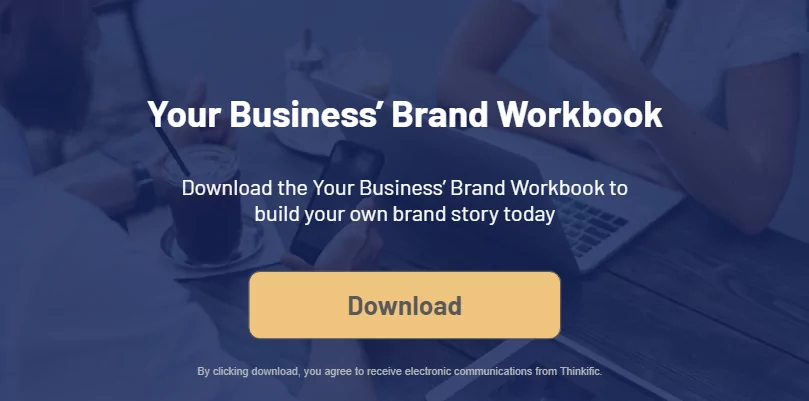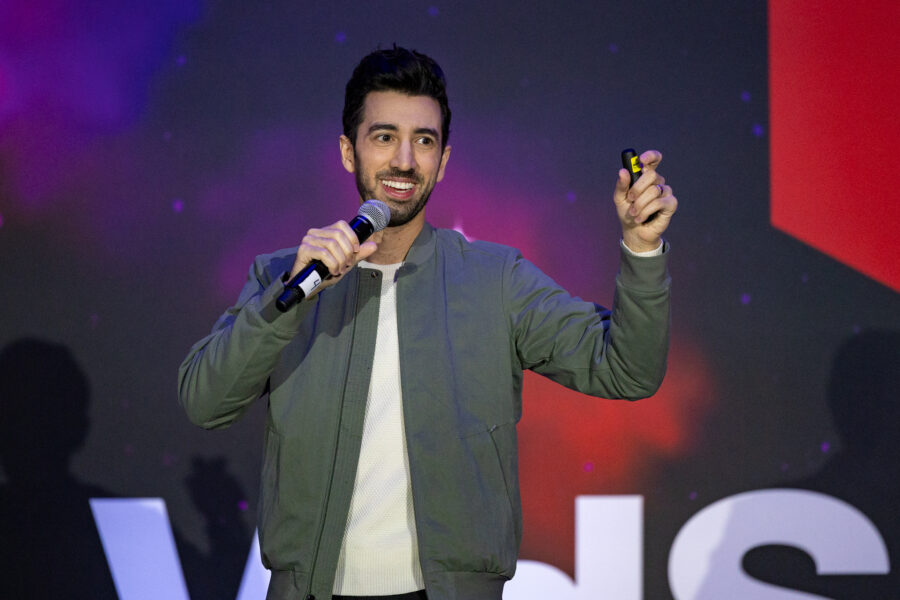As humans, we’re built to understand our lives through stories – we learn, explain and empathize by telling stories to each other. Marketing your brand is no different. If you want to reach your audience and build a closer connection with them, you need to write your brand story.
Read on to find out more about what is a brand story – including the essential elements of a good brand story, and a workbook to help you write your own.
Learn more about the best marketing strategies for your business – sign up for our Free Webinar Sales Funnel course.
What is a brand story?
A brand story is a narrative of how your brand began. It encompasses the emotions, motivations, and vision that led to you starting your business and how all of those things shaped it into the brand it is today.
The best brand stories combine both facts and feelings to create a colorful narrative. They also have strong characters, challenges, and sometimes conflict. Think of your brand story like your business’ origin story – it is the tale of how your business became the superhero it is today.
Why brand stories work
The reason brand stories are so effective is that they appeal to your audience’s emotions. When humans judge something, we use 20% logic and 80% emotion. Emotion drives our decision-making process and logic then backs up that decision and helps us to rationalize and justify it.
If you can appeal to emotion, you can get your audience to buy into your brand in a more powerful and long-lasting way. Brand stories distill the complex story of your business into a simple and succinct tale that customers can get invested in. With the right story, you can win your audience’s hearts and minds and transform them into loyal customers.
How to find your brand story
Writing your own brand story is an individual process.
The best brand storytelling elements will be rooted in your own experience of starting your business and the people who motivated you to talk the plunge. If you’re wondering what is a brand story, think about the steps you took to become an entrepreneur.
Try answering these 5 questions:
- Why did you decide to start this business?
- How did you get to this point?
- What challenges did you face along the way?
- What desire or need does your service/product fulfill?
- What makes your service/product unique?
These questions will give you the foundation for your brand story. The idea is to get to the heart of why you set up your business and who your product or service is designed for.
What is a brand story? 4 essential elements
The best brand stories have a few key similarities that help your audience to connect to your brand. If you want to craft an impactful brand story, try to keep these points in mind.
Define your mission
At the heart of a good brand story is your brand mission. This is essentially how you hope to help people and make the world a better place. Your brand mission is centered on your ultimate vision for your business. In an ideal world, what change would you like to see?
When you’re writing your mission, try to keep it short, descriptive, and inspirational.
Here are some examples:
- Starbucks “To inspire and nurture the human spirit – one person, one cup and one neighborhood at a time.”
- Oxfam “A world without poverty”
- Typeform “Really know people”
What these brand stories all have in common is a simple, idealized vision of what they hope to achieve with their business.
Highlight any challenges or barriers
The best brand stories also involve some kind of challenge or conflict. Starting a business is never plain sailing so when you’re writing your brand story, make sure you also include the challenges you faced. This is a really important step to help your audience build an emotional connection with your brand.
Remember: what is a brand story? It is the series of events that led to you starting your business. That means the good and the bad.
What challenges have you overcome?
Any good story features a challenge or barrier that stops the protagonist from successfully completing their goal in chapter 1. When you’re writing your brand story, try to think about the challenges you’ve overcome.
Here are some ideas to get your started:
- Limited resources
- Powerful competitors
- Cultural pressure or resistance
- Personal struggles
Again, this will be personal to you and your experiences as an entrepreneur. What challenges did you have to go up against to establish your business? Who or what stood in your way of success? By drawing out the conflict in your story, you can hook your audience and encourage them to become more invested in your brand.
Example of a conflict-driven brand story
One of the best known brand stories of our generation is Apple.
Apple’s brand story is a perfect example of entrepreneurs overcoming immense challenges to bring their product to market and transform their start-up into a multi-billion dollar success.
The story goes that two college dropouts – Steve Jobs and Steve Wozniak – set up Apple in their garage. Together, the two went head to head against Microsoft, a well-established business at the time, to bring the world a product that was new, innovative and different. Today Apple still retains that creative, inventive ethos that can be traced back to two guys tinkering in their garage.
Apple’s status as a cult brand is thanks in part to this powerful brand story.
Though it is now a multinational brand with over 1 billion loyal fans, they have managed to maintain a close emotional connection with their audience by rooting their business in the tale of two ordinary guys.
Provide a resolution
What is a brand story without a happy ending? To create a satisfactory brand story, you also need to offer your audience a resolution. Once you have set up your conflict, it’s time to complete the narrative arc.
What happened next? How did it all work out? What are you looking forward to in the future?
The resolution is the point at the end of the superhero story, after the epic battle against the aliens when the main characters meet again and share their witty one-liners. It is the time when the audience lets out a sigh of relief that the enemy has finally been defeated and we get to see our heroes back home safe and in their everyday lives.
This is the chance to give your brand story a secure, satisfying ending.
Here’s an example from the Wallbreakers brand story:
“Today, candidates receive the certifications they need to stand out to top employers, while companies can rest-assured their incoming talent is trained to meet their specific needs. It’s a win-win.”
Read the full Wallbreakers brand story and case study here.
Don’t worry about the fact that your brand story is still ongoing – it’s the same for every business. You just need to provide your audience with a positive ending to your story.
Condense it down
The best brand stories are short and easy to remember.
Once you’ve written your brand story, you need to condense it down into the most important parts and most emotive details.
Your audience doesn’t want to read an essay. You run the risk of losing interest if your brand story is too long or confusing. To build an impactful brand story, try to keep your narrative simple and informative.
Ideally, you should be able to tell your story in just 1-2 paragraphs.
The Thinkific brand story goes like this:
Thinkific was conceived when co-founder and CEO Greg Smith decided to take his LSAT course online with the help of his brother Matt Smith to reach more students. For Greg, taking his course online meant an opportunity to reach more students globally, and to generate more revenue and freedom.
The revenues from his online course soon surpassed his corporate law practice, and as the course took off and helped more students, other entrepreneurs and businesses reached out asking how they could do the same. They wanted to sell their own courses on their website and drive business growth under their own brand, with full control over their content, data, and business. So, Greg and Matt, along with co-founders Miranda Lievers and Matt Payne, set out to build the best platform for course creators and businesses.
The Thinkific brand story distills the complex series of events that led to the creation and growth of the brand into a simple story that anyone can understand. It’s short, straightforward, and highlights the most important parts of the brand’s journey.
Top tip: When you’re writing your brand story, try to make it retellable – the best brand stories are ones that people are motivated to share with others.
Brand story examples
If you need inspiration for your own brand story, it can be a huge help to look at other well-established brands for ideas.
Social media is a great place to start finding inspiration for your brand story. The short, informal format of social media is the perfect place for brands to highlight their brand story.
Check out these examples of brilliant brand stories from Thinkific course creators.
The SuperLearner Academy
Jonathan Levi has built a community of over 80,000 students in 186 countries with his online school centered on speed reading and memory skills.
Levi’s inspirational personal story of how he overcame his own struggles with learning is at the center of the SuperLearner brand story.
The SuperLearner Academy utilizes this powerful brand story on the main landing page for the site:
Levi even includes his high school report card and a photo of himself as a teenager to create an even more powerful emotional connection with his audience.
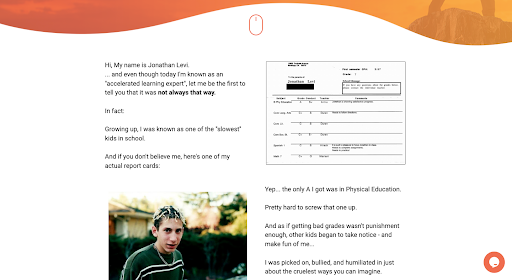
Tori Swanson
An artist, entrepreneur and educator, Tori Swanson has put her personal journey at the heart of her brand story.
After battling an eating disorder, Swanson was motivated to help others learn to embrace their bodies through art and nude sketching.
Here’s an example of how her moving brand story helps promote her brand on Twitter and YouTube:
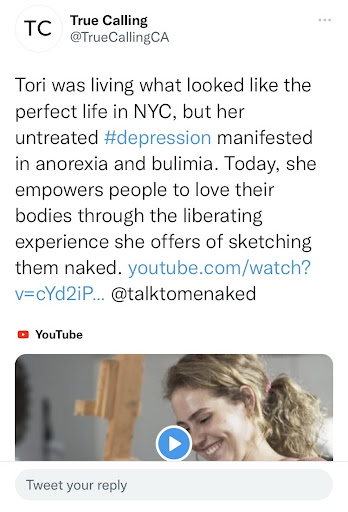
Miss Excel
Kat Norton successfully grew her Miss Excel course into a six figure online business with a strong brand story at its core.
Norton was determined to make it fun and easy for anyone to become an Excel expert.
Here’s an example of her brand story on Instagram:
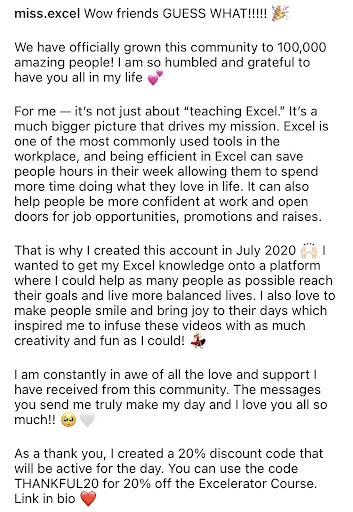
Norton highlights her overall brand mission and demonstrates her emotional investment in the Miss Excel brand, encouraging her followers to do the same.
What is your brand story?
Now you have a clear idea of what is a brand story and how to write your own, download the Your Business’ Brand Workbook and sign up for Neil Patel’s Free Webinar Sales Funnel online course for more marketing tips and tricks.


